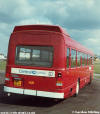 | In the early days of the red and cream colour scheme, red was very much the predominant colour, seen here relieved only by a cream band. |  | Later, a second cream band was added between the decks, giving a slightly lighter effect. |  | By the time the last Leyland Titans appeared, the standard Central SMT look had been established with the use of cream window surrounds. |
 | This layout was also used to great effect on the superb Lodekka fleet. | _small.jpg) | SBG corporate style fleetnames were introduced in 1978. In order to accommodate the new fleetname, a revised livery layout was applied, extending the lower-deck window surround into a between-decks band. | _small.jpg) | In the late 70s, there were some short-lived experiments with a creamier version of the livery. |
_small.jpg) | A striking Redline version of the livery was worn by the small Leyland Olympian fleet. |  | T174 shows the standard single-deck version of the traditional livery, with cream waistband and window surrounds. |  | This livery required no modification in order to accommodate the new corporate-style fleetname in 1978. |
_small.jpg) | T370 shows the original version of the livery applied to the first Alexander T-type bodied buses. |  | An innovative and very effective zig-zag scheme was introduced for the new TE/TS Tigers. |  | For many years, Central maintained a small fleet of Bedford / Duple coaches in this distinctive two-tone blue livery. |
 | Later coaches featured variations on the red and cream theme. |  | One of the local identites introduced in 1989 was Monklands Bus. The livery was inspired by the former independent Baxter's of Airdrie. |  | Another of the local identities was EK Chieftain, inspired by Laurie, Hamilton. |
 | The third local identity was Lanarkshire Bus, featuring a more vibrant version of red and cream. | | | | |
 | The standard colour scheme for the Central SMT Leyland National featured a large cream area, including the traditional Central treatment of window surrounds. |  | The first National IIs appeared in allover red, relieved only by the fleetname panels. |  | My favourite! Some of the ex-Eastern Scottish Nationals retained their previous owner's preferred layout, with window surrounds in the main fleet colour. |
 | This very odd experimental livery was tried out on N25, but thankfully led to nothing. |  | Less creamy experimental liveries were also tried on the original Mk I Nationals, as seen in this view of N5. |  | N51 (seen here) and N54 were both selected to receive the Monklands Bus colour scheme. |